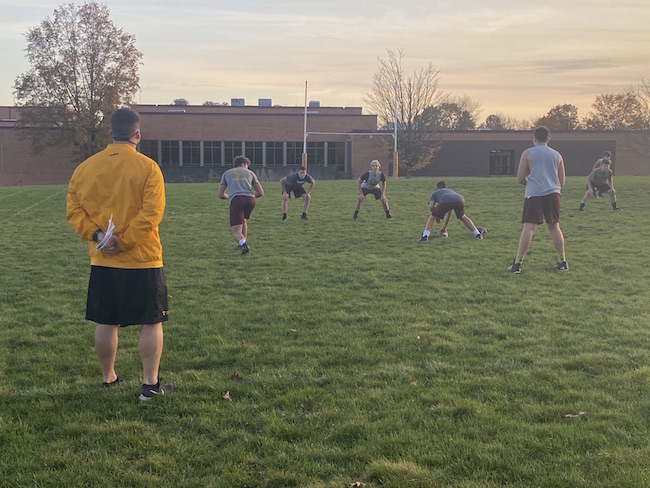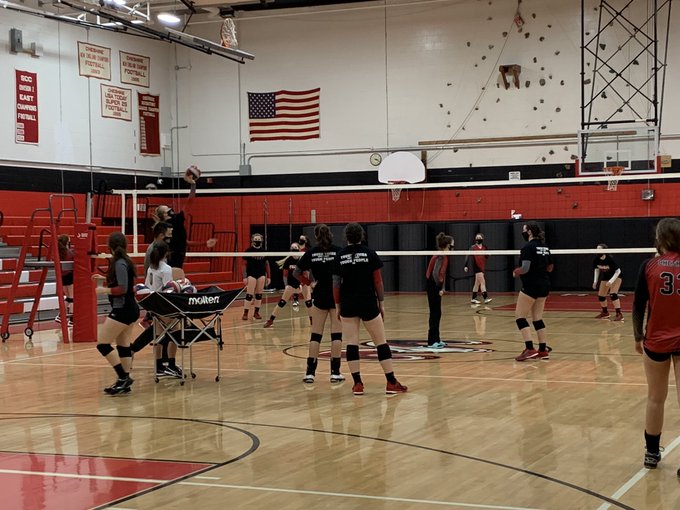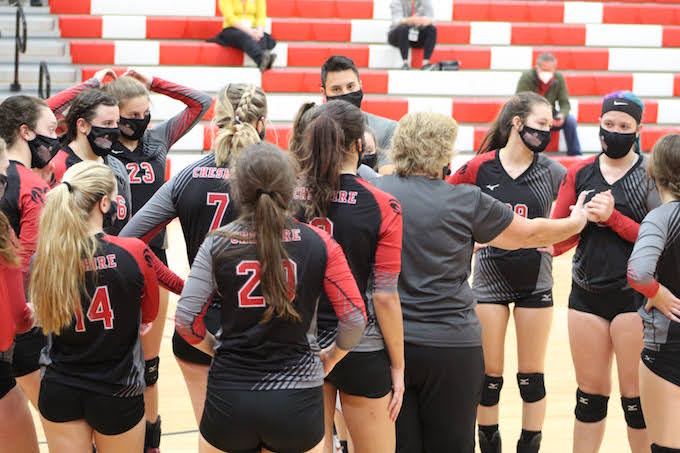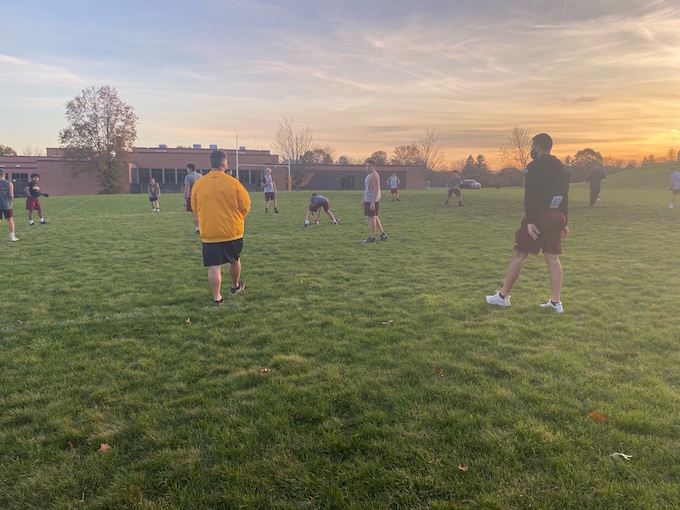By: Eric Kerr

Where it all began
Connecticut high school sports went to the sidelines in March as COVID-19 raged across the eastern United States. This meant that thousands of athletes missed the full spring season.
“Last year was a year we probably would have won the state title,” said Sue Bavone, head coach of the Cheshire boys’ high school volleyball team. “That was pretty devastating for those seniors.”
The virus threatened to postpone fall and winter sports too, as it forced Connecticut high school sports officials and the state Department of Health (DPH) to figure out whether to play.

Fall begins
The Connecticut Interscholastic Athletic Conference (CIAC) and the DPH Public Health set a plan that allowed the fall season to begin on Aug. 29. Practices were limited to cohorts of 10 students until Sept. 21, and schools could determine on their own if they wanted to move to full-team practices after this date.
The early practices became tryouts, as coaches adjusted to the new format. For Kevin Fitzsimmons, head coach of Weston boys high school soccer, deciding whether to keep players of the same position together or mixing players of different positions into cohort groups was no easy task.
“I already thought the high school job was demanding,” said Fitzsimmons. “But that just really tripled our workload.”
On Oct. 1, regular season games started, but the CIAC’s plan created different schedules for each team.
The CIAC split Connecticut’s Southwestern Conference (SWC) of 14 teams into two separate divisions, a north division and south division. Weston was a member of the south division with seven other teams.
Cheshire girls volleyball had a similar regular season schedule. Its conference, the Southern Connecticut Conference (SCC) cut down its four divisions into three: A, B and C. Cheshire was placed into the B division with five other teams, based on the geographic location of other teams.
The playoffs were also unique. All Connecticut fall sports teams played in a small tournament with just division opponents. With the new postseason format, teams missed the opportunity to compete for a conference title.
“I would like to be able to at least play an SCC tournament,” said Bavone. “That bothers me because I like to play for championships.”
Fall begins (for some)
Oct. 1 wasn’t the start date for every fall sport, as 11 vs. 11 football was canceled in Connecticut.
Coaches and players in the state were frustrated. Coaches were emotional thinking about their players, especially the seniors.
“It was disheartening,” said John Ferrazzi, head coach of Sheehan high school football. “Your thoughts automatically go to your seniors … For a lot of the seniors, it would be their last hurrah playing. For others who have aspirations to go on and play in college, you need a senior season.”
Joe Aresimowicz, head coach of Berlin high school football and Connecticut’s Legislature’ of the House, wrote a letter to Connecticut Gov. Ned Lamont requesting for football to be played.
“Connecticut coaches are ready to do everything possible to allow the athletes to play the sport they love,” Aresimowicz wrote in the letter. “Many other sports are currently being played with protocols in place to prevent an uptick in cases. The football community is poised to do the same.”
High school football teams participated in two rallies in September attempting to bring the game back.
Jason Villano, a senior captain on the Sheehan football team, spoke at a rally in West Hartford. He sent a message to the CIAC and Lamont to think about what missing a senior year in football means for him and other seniors in the state.
“The lack of a true football season and its repercussions is something that will be lost for myself and my fellow football players across the state for the rest of our lives,” said Villano.
This message would be answered. On Sept. 29, The CIAC changed their decision from cancelling football, to postponing it to the spring.
“It was kind of like a weight being lifted off of my shoulders,” said Villano. “Being a senior, that’s all you can ask for (the CIAC) taking initiative and putting a plan in place.
Players were aware that if they didn’t speak up, the option for a spring season could have been off the table.
“I believe our voices and protesting at the Capitol in Hartford was a reason why we have this spring option now,” said Bill Gorry, another senior captain on Sheehan’s football team. “Since we got our voices out, we were able to get that option.”
To prepare for 11 vs. 11 in the spring, Connecticut high school football teams were allowed to play 7 vs. 7 football this fall. No pads were worn, no lineman were present and two-hand-touch was in place of tackling. Lineman played in separate challenges, ranging from tug-of-war, sled drives and tire flips.
Players and coaches knew this wasn’t ideal, but they at least knew they were working for an actual season in the future.
“We were excited when we learned that there is a glimmer of hope for the spring,” said Pat Miller, head coach of Norwalk High School football. “We’re trying to do all the right things, so we can have that.”
How did this go?
By November, coronavirus cases rose in Connecticut, complicating existing plans for high school sports.
At least 25 schools in the state had to reschedule games in response to the number of COVID-19 cases in their district. Schools such as Lyman Hall and Norwalk had to cancel games to keep their players safe.
Some teams, however, escaped cancellation. Cheshire girls volleyball and Weston boys soccer had to quarantine only a few players on their junior varsity (JV) teams, upon being contact traced to separate positive tests.
Fitzsimmons was quarantined for two weeks. He too was contact traced from someone who tested positive. While away, Chris Myers, his assistant coach, oversaw both the JV and varsity practices in his place.
“It’s tough, but thankfully he got it done.” said Fitzsimmons.
Masks on
The CIAC presented a challenge to Connecticut high school volleyball when all players and coaches were required to wear masks for games and practices. Players could only take off their masks during water breaks.
Such protocols made it difficult for Bavone to communicate with her team. She purchased an audio amplifier, in order for her coaching instructions to be heard on the court.
“To yell in the mask … it’s exhausting,” said Bavone. “The amplifier definitely helped me with coaching on the sidelines, because if I didn’t have that … they just wouldn’t hear me at all.”

Despite a season unique from any other, several are thankful that they played.
“We are grateful that we actually were able to have a season,” said Bavone.

“It’s different … but again it’s allowed us to play,” said Fitzsimmons. “I got to thank them (CIAC) for what they do.”
A day in the life of a Connecticut high school football practice in 2020
On Nov. 5, Sheehan high school moved to remote learning for two weeks.
Despite the change, the Sheehan football team still practiced that day. The players and coaches were eager to be out on that field for much as possible.
“As long we get permission to be out here and practice and be out here with the guys, then that’s what we’re going to do,” said Villano.
Villano’s words reigned true. The 7 vs 7 drills with the receivers and quarterback ran as normal. All coaches wore masks, and players did not wear pads. The only difference was that lineman were not in attendance.

Gorry was part of the crew who missed practice that day, and he said he would have rather been on the field than stuck in his house.
“I was sad,” said Gorry. “I don’t want to be at home. I want to be with my teammates. I want to be out there with them.”
That same day, the CIAC delayed the start date for the winter sports season. Two weeks later, the winter sports season was pushed back to Jan. 19. No teams can begin practicing until that date. No games will start for the winter season until after 10 days of practices.
The news of delayed winter sports season back in early November influenced Ferrazzi to share this message in the huddle at the end of the Nov. 5 practice.
“It looks like it’s getting worse now, before it’s getting better.” said Ferrazzi. “We can still come out here and utilize the time while we have it. We don’t know when the last time will be when we are out here. Let’s live for today.”

